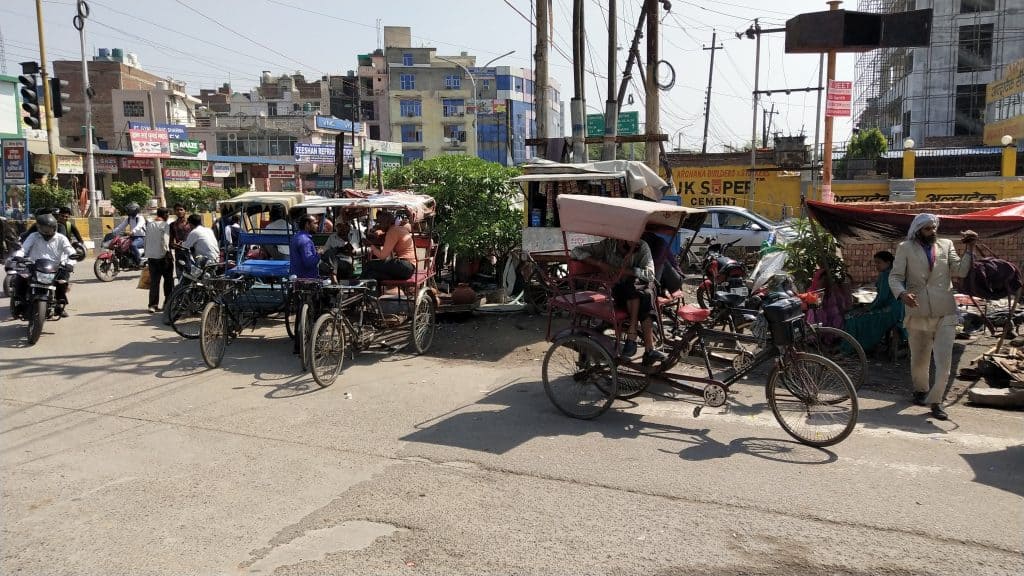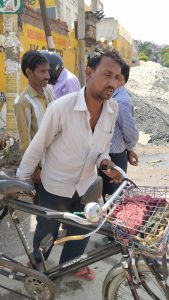28-year-old Kamlesh Kumar moved to Uttar Pradesh’s Noida from Patna eight years ago, in pursuit of a better life. Kumar is one among thousands of rickshaw pullers (rickshaw-wallahs), mostly in their mid-20s or early 30s, who moved to Noida in the Delhi National Capital Region (NCR), to try their luck and earn better wages and better standards of living than they could dream of in their home towns.
Reality however has been less benevolent. Noida or Gautam Buddh Nagar’s rickshaw wallahs often find themselves constantly trying to juggle the hardships of rent, finding cheap food and getting affordable medical treatment. According to the official website of Gautam Buddh Nagar, the city’s population is 16.48 lakh and it is believed around 20,000 tricycle rickshaw pullers live in the city. But what is life like for them in a city as expensive as Noida?
Earnings vs cost of living
Take Kamlesh for example. Working six days a week, he earns a meagre Rs 300-400 per day (Rs 9,000-10,000 a month) by ferrying office goers and students in and around Labour Chowk in Noida’s Sector 58. Sunday is his weekly break, as roads remain deserted on this day. He spends Rs 3,000 per month as rent for a single, small room in Bishanpur village in Sector 58. Bishanpur is a home to hundreds of such poor labourers who often share a single room with two or three people.
Another 3000 odd rupees goes towards food and at the end of the month, he is barely able to save Rs 2000 or 3000, which he sends his family back home. In case he falls sick ever, this paltry savings too becomes impossible as there are medical expenses to be met. And yet, he somehow managed to save Rs 10000 over almost a year and bought a smartphone, which is his only source of entertainment as well as his connect with his family. He spends Rs 200 a month to access Internet and this enables him to talk to his family back home every evening.
Kamlesh also talks about how every government promises to provide cheap LPG gas, housing for poor and affordable ration for have-nots like him, but these inevitably turn out to be poll-time promises that are made to be broken.
This is just one among countless similar stories that you will hear from Noida’s urban poor and migrant labour, who come here from India’s remotest parts. These are the workers who provide much of the informal services in the city, thus helping it to function smoothly. The number of labourers and rickshaw pullers in the city has gone up steadily, as the middle class here has grown too and thus created increasing demand for more services. And yet, they continue to live in the shadows of urbanisation.
Another rickshaw puller, Manglu has a different story to share. He hails from North Dinajpur district of West Bengal and has been working in Noida for the past five years. Manglu says he works in Noida for six months and goes back to Dinajpur to work as a daily wage labourer there, as his family wants him to be with them for at least six months in a year.
Manglu, too, comments on how every government has failed the poor, unable to resolve their issues or make lives any better for them. His eyes well up as he talks about the many hardships that he has to endure only to be able to earn Rs 300 a day. If he is lucky then the amount of such daily earning may go up to Rs 350.
Every month, Manglu has to spend Rs 2,300 for room rent and around Rs 2,500-3,000 for food. He says he does not spend any extra money for the smallest of indulgences, as that would make it difficult for him to save money for his family back in West Bengal. While he does own a second-hand smartphone, he is unable to recharge this every month given the paucity of money.
Sanjeev, hailing from Bihar’s Lakhisarai, is one of the lucky rickshaw pullers in the city, who has bought an LPG cylinder after saving for months. He earns Rs 9,000 a month, which sometimes goes upto Rs 12,000 if he is lucky. Finding that eating out every day was not feasible, he saved money to buy a cylinder. This helps him save around Rs 1,000-1,500 per month, which he sends his family.
However, he stresses on the need of reducing the price of a gas cylinder and feels that the government should give 40-50 percent subsidy to the poor to refill their cylinders to make it affordable for all.
Sanjeev enlightens me about another interesting, unwritten rule among rickshaw pullers. Sometimes he takes his rickshaw to other sectors of Noida and does business there. But this is not easy, because rickshaw pullers of other areas do not welcome their counterparts from elsewhere, as it impacts their daily earnings. “There is a fixed zone for every rickshaw-wallah in entire Noida and sort of unwritten rules which say that rickshaw wallahs should not trespass into others’ territory,” he explains.
Living conditions
Bishanpur is a congested village. Most of the rickshaw-pullers here shell out roughly Rs 2,000-3,000 as monthly rent for a damp, unventilated one-room house crammed somewhere in the narrow and foul-smelling streets of Bishanpur.
Kamlesh, for example, lives in a single room in a multi-storeyed building shared by two other people. The rooms sport a single electricity connection for one tube light or a bulb, a fan and a TV. He says owning a cooler fan is like a dream for them and they spend the blistering summer under a single ceiling fan.
Such multi-storeyed buildings usually have around 10-15 rooms that are let out, but which have common toilets. Kumar points out that the common toilets are in poor condition and unhygienic, as owners do not take the pains to have them cleaned, leaving it to the occupants to clean and maintain them. The results: poor hygiene and unsanitary conditions.
When asked about what it feels to live in a small room, Kumar says it does not matter to him. All he wants is a shelter with a roof, potable water and a ceiling fan. Sometimes, the landlord offers cold water to them to quench their thirst in the blistering summers.
Manglu also shares his room with two other men. One of them works as a security guard while the other works as an office boy in a private firm. He says sharing a room with unknown was the biggest challenge when he first rented the room, but after a few months he mingled with other occupants. Renting an exclusive room for oneself is a luxury people like Manglu cannot afford.
“People like me do not really care about where they stay and under what circumstances they live in; rather, it is all about how much money we can save for our families,” he says. But why not also bring the family here?
“I do not wish to keep the family in such deplorable conditions. Besides, education is too expensive here,” he says.
Why Noida then?
Why, despite, such conditions do people like Manglu and Kamlesh still follow the ‘city dream’?
One of the reasons behind increasing migration is the rapid growth of the NCR in recent decades. According to a March 2017 report by KPMG on ‘urbanisation in the National Capital Region’, the NCR contributed almost 7% to India’s GDP in 2009-10 fiscal. With increasing job opportunities in the formal sector, the population has gone up in Delhi and Noida, and consequently the demand for services.
The KPMG report states that NCR boasts of a huge transport network which includes road, metro rail and rail corridors which caters to intra-city, inter-city commuters and long-distance traffic. Rickshaw pullers offer critical last mile connectivity for such public transport, and hence earn a fairly steady amount of money every month. That is not something they can be assured of in their home towns. Thus while it is not uncommon to find them earning Rs 10000 a month in the city, back home the highest earning would probably be to the tune of Rs 5000, irrespective of how hard they work.
Sometimes, they even hide their city identities. Kamlesh confided that he has not disclosed his occupation to the people in his hometown Patna. “My relatives and friends would jeer at me, if they learn I am a rickshaw puller. But there are no jobs in Patna and even if I rent a hand-rickshaw in Patna, I would not be able to earn this much,” he said.
Going back to his native village and starting afresh is not an option either. “I am not skilled labour who can go anywhere and start a new life. With whatever I am earning, I am happy to be here,” he says.
E-rickshaws cause concern
Economic prospects of migrant rickshaw pullers may see a dent with the introduction of e-rickshaws, however. The new e-rickshaws take four to five people on a single ride, charging each person Rs 10 for the ride. Many have thus begun to prefer e-rickshaw for commuting short distances.
“We have lost our business to mushrooming e-rickshaws in Noida. A few years back there used to be around 40-50 rickshaw wallahs in a particular area, but now e-rickshaws have increased in number,” Kamlesh says.
Why doesn’t he buy one then? “Raising Rs 50,000-60,000 for an e-rickshaw is impossible for people like me, always on a shoestring budget. Buying a used tricycle rickshaw is much more feasible, as they cost around Rs 3,000,” he explains
Mohammad Afsar who belongs to UP’s Bulandshahar also agrees that e-rickshaws have affected his earnings. Not only this, but the newly launched Ola bike is also worrying many rickshaw wallahs.
Schemes for the urban poor
Though there are a number of government welfare schemes, a huge number of rickshaw-pullers have not been able to avail the benefits of those schemes for various reasons.
The Pradhan Mantri Awas Yojana (Urban) is one such welfare scheme for the urban poor. According to the housing and urban poverty alleviation website, a beneficiary family can comprise husband, wife and unmarried children, who should not own a pucca house (dwelling unit) either in his/her name or in the name of any member of his/her family in any part of India.
Even if one did satisfy the above condition, many rickshaw pullers seemed to believe that they were not literate enough to apply for the PM’s housing scheme. Kamlesh himself said that he had thought of applying for a house under the scheme, but when he learnt that the process is complicated and he needs to visit the district magistrate’s office, he gave up on it.
“I am not literate and can’t fill forms and make rounds of government offices. Besides, even if I manage to complete all the formalities, who would compensate me for the earnings lost over that duration?” he asks.

